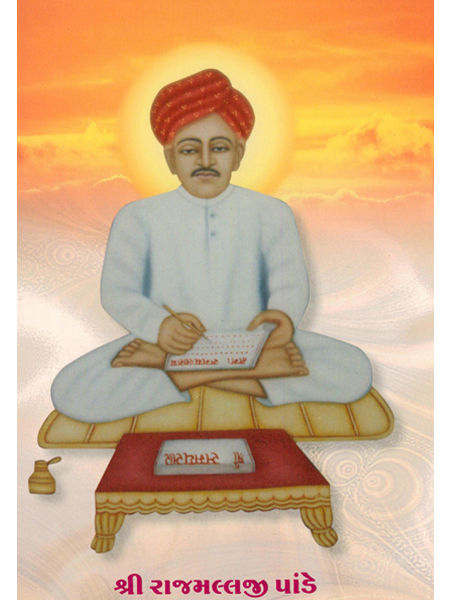
Pandey Rajmall Ji and His Baalbodhini Tika
Pandey Rajmall Ji lived during the reign of Mughal Emperor Akbar and continued into the era of Shah Jahan, residing in Virat Nagar near Jaipur. The renowned poet Pandit Banarsidas, who lived shortly after Rajmall Ji, respectfully referred to him with the honorific “Pandey” in the verse:
“Pandey Rajmall, follower of Jain Dharma, connoisseur of the Natak Samayasaar.”
It is likely that the term “Pandey” here was not used as a caste identifier, but rather as a respectful title meaning “Pandit” or “Scholar,” which is also evident from his life story.
Life of Pandey Rajmall Ji
During Akbar’s reign, a merchant named Bharu lived in Virat Nagar under the spiritual lineage (Amnaya) of Bhattaraka Kshemakirti. Bharu had four sons:
- Dooda
- Thakur
- Jagasi
- Tilok
Dooda had three sons:
- Nyauta
- Bholha
- Faman
Faman, for some purpose, came to Virat Nagar and received Jain religious education from Talhu, a scholar of Hemachandraacharya’s lineage. Later, Talhu introduced Faman to Pandey Rajmall Ji, and at Talhu’s request, Rajmall Ji composed the text Latīsamhita.
Subsequently, Pandey Rajmall Ji authored the renowned commentary Samayasaar Kalash Tika, an exposition on the verses known as Kalash from Acharya Amritchandra Suri’s commentary Atmakhyati on Acharya Kundkund’s Samayasaar.
He also wrote several other works:
- Panchastikaya Tika
- Panchadhyayi
- Jambuswami Charitra
- Pingal-Chhanda Shastra
- Adhyatma Kamal Martanda
His active period is considered to be between Vikram Samvat 1632–1650 (17th century Vikram era).
Was Pandey Rajmall Ji a Kasthasanghi?
A common doubt arises: “Wasn’t he a Kasthasanghi? Then how could he belong to Kundakund’s lineage?”
This concern is unfounded. There is no evidence that Pandey Rajmall Ji was a Kasthasanghi.
His contemporary, Bhattaraka Kshemakirti, belonged to the Kasthasangh, specifically the Mathura Gaccha of the Pushkara Gana, and operated within the 37 Bhattarakas’ lineage of the Natak Samayasaar. Although this lineage does not align with Kundkund’s tradition, Kshemakirti was deeply influenced by Kundkund’s spiritual philosophy. Recognizing Rajmall Ji’s profound understanding of Jain philosophy, Kshemakirti encouraged him to write detailed commentaries in the vernacular so that lay Jains unfamiliar with Sanskrit and Prakrit could grasp Kundkund’s teachings.
Thus, while Kshemakirti was from the Kasthasangh, he was spiritually aligned with Kundkund’s tradition. There is no proof that Pandey Rajmall Ji himself belonged to the Kasthasangh. It was a coincidence that both were contemporaries, and Kshemakirti, impressed by Rajmall Ji’s intellect, advised him to interpret Kundkund’s texts in the local language.
This confirms that Pandey Rajmall Ji was a profound scholar and spiritual practitioner of Jain philosophy, who even influenced Bhattarakas from different lineages to embrace Kundkund’s original tradition.
Therefore, the claim that the illustrious author of Samayasaar Kalash Tika, Pandey Rajmall Ji, was a follower of the Kasthasangh lineage is baseless and irrelevant.
Scholarly Brilliance of Pandey Rajmall Ji
As the author of Samayasaar Kalash Tika and other timeless works, Pandey Rajmall Ji was a master of grammar, prosody, Jain doctrine, Syadvad, and spiritual philosophy. His intellectual prowess was widely acknowledged by his contemporaries and successors. In Latīsamhita, he describes himself as:
“syādvādānavadya-gadya-padya-vidyā-viśārada”
Modern scholar Pandit Parmanand Shastri highlighted his brilliance, stating:
“Many have been able to savour the essence of spirituality through Rajmall Ji’s Kalash Tika. His personality was influential, and he was always driven by a spirit of public welfare. Especially in Rajasthan’s Marwar and Mewar regions, he travelled extensively, earning fame and respect. His pure conduct and altruistic intellect were hallmarks of his scholarly life. His works Adhyatma Kamal Martanda and Panchadhyayi reflect his spiritual experience and mastery of Syadvada. Wherever he went, he was warmly welcomed.”
Distinctiveness of Baalbodhini Tika
Rajmall Ji named this commentary Baalbodhini Tika, and likely adopted a word-by-word explanatory style to make it accessible.
Although this commentary is based on the Kalash verses from Amritchandra Suri’s Atmakhyati on Samayasaar, it treats these verses as nearly independent compositions rather than as part of the full Atmakhyati. This shows that Rajmall Ji considered the Kalash verses as original and worthy of standalone interpretation.
Despite its name, Baalbodhini is not a simplistic commentary. It is a mature and profound work, reflecting Rajmall Ji’s scholarly depth. Its language is simple, making the title Baalbodhini appropriate, but the content is intellectually rich.
20th-century Jain scholar Pandit Phoolchandra Siddhantacharya praised the work:
“This commentary reveals its nature in alignment with the path to liberation, making it authoritative. It is based on scripture, guru’s teachings, reasoning, and direct experience. A work that is not inherently authoritative cannot gain authenticity externally. Though written in the Dhundhari dialect, it is imbued with poetic elegance and stylistic richness that delight noble minds.”
He further noted that Rajmall Ji interpreted each word not merely by literal meaning but through its deeper essence. Thus, this is not a commentary that merely explains words, it reveals the spiritual secrets behind them.
Using the teachings of Acharya Kundkund and Acharya Amritchandra Suri as its foundation, Rajmall Ji’s Baalbodhini Tika also known as Samayasaar Kalash Tika employs a language style and thematic approach that reflect the spirit of the age and the depth of Jain philosophy.